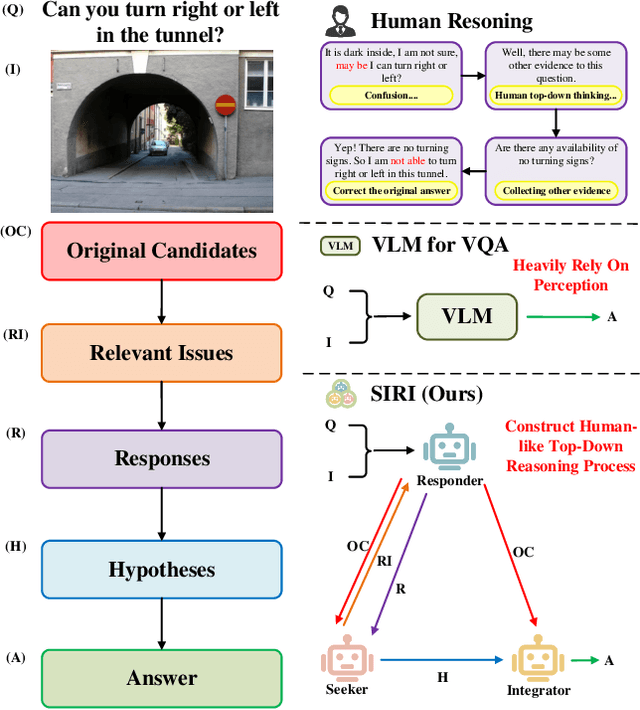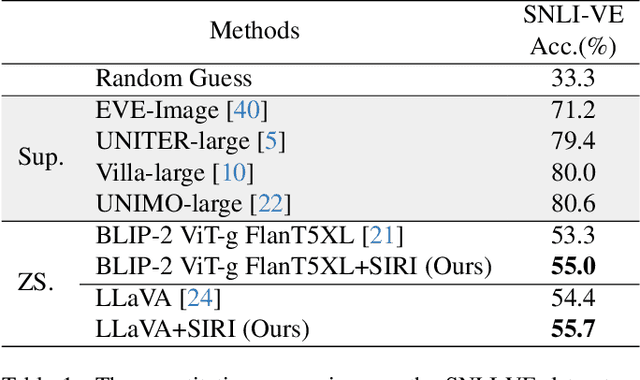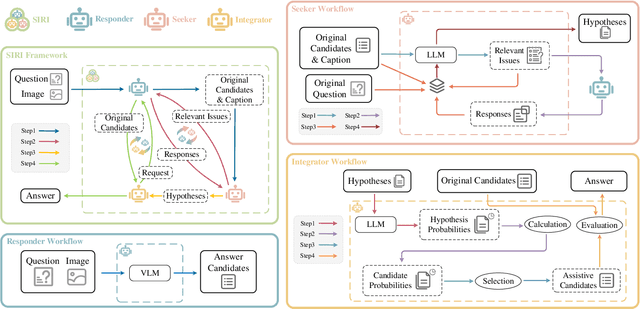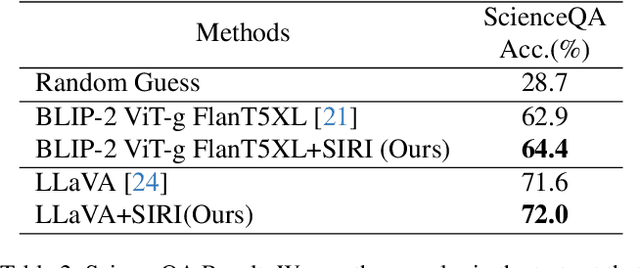Wentao Wan
SR-FoT: A Syllogistic-Reasoning Framework of Thought for Large Language Models Tackling Knowledge-based Reasoning Tasks
Jan 20, 2025Abstract:Deductive reasoning is a crucial logical capability that assists us in solving complex problems based on existing knowledge. Although augmented by Chain-of-Thought prompts, Large Language Models (LLMs) might not follow the correct reasoning paths. Enhancing the deductive reasoning abilities of LLMs, and leveraging their extensive built-in knowledge for various reasoning tasks, remains an open question. Attempting to mimic the human deductive reasoning paradigm, we propose a multi-stage Syllogistic-Reasoning Framework of Thought (SR-FoT) that enables LLMs to perform syllogistic deductive reasoning to handle complex knowledge-based reasoning tasks. Our SR-FoT begins by interpreting the question and then uses the interpretation and the original question to propose a suitable major premise. It proceeds by generating and answering minor premise questions in two stages to match the minor premises. Finally, it guides LLMs to use the previously generated major and minor premises to perform syllogistic deductive reasoning to derive the answer to the original question. Extensive and thorough experiments on knowledge-based reasoning tasks have demonstrated the effectiveness and advantages of our SR-FoT.
Is this Generated Person Existed in Real-world? Fine-grained Detecting and Calibrating Abnormal Human-body
Nov 21, 2024



Abstract:Recent improvements in visual synthesis have significantly enhanced the depiction of generated human photos, which are pivotal due to their wide applicability and demand. Nonetheless, the existing text-to-image or text-to-video models often generate low-quality human photos that might differ considerably from real-world body structures, referred to as "abnormal human bodies". Such abnormalities, typically deemed unacceptable, pose considerable challenges in the detection and repair of them within human photos. These challenges require precise abnormality recognition capabilities, which entail pinpointing both the location and the abnormality type. Intuitively, Visual Language Models (VLMs) that have obtained remarkable performance on various visual tasks are quite suitable for this task. However, their performance on abnormality detection in human photos is quite poor. Hence, it is quite important to highlight this task for the research community. In this paper, we first introduce a simple yet challenging task, i.e., \textbf{F}ine-grained \textbf{H}uman-body \textbf{A}bnormality \textbf{D}etection \textbf{(FHAD)}, and construct two high-quality datasets for evaluation. Then, we propose a meticulous framework, named HumanCalibrator, which identifies and repairs abnormalities in human body structures while preserving the other content. Experiments indicate that our HumanCalibrator achieves high accuracy in abnormality detection and accomplishes an increase in visual comparisons while preserving the other visual content.
Towards Top-Down Reasoning: An Explainable Multi-Agent Approach for Visual Question Answering
Nov 29, 2023



Abstract:Recently, Vision Language Models (VLMs) have gained significant attention, exhibiting notable advancements across various tasks by leveraging extensive image-text paired data. However, prevailing VLMs often treat Visual Question Answering (VQA) as perception tasks, employing black-box models that overlook explicit modeling of relationships between different questions within the same visual scene. Moreover, the existing VQA methods that rely on Knowledge Bases (KBs) might frequently encounter biases from limited data and face challenges in relevant information indexing. Attempt to overcome these limitations, this paper introduces an explainable multi-agent collaboration framework by tapping into knowledge embedded in Large Language Models (LLMs) trained on extensive corpora. Inspired by human cognition, our framework uncovers latent information within the given question by employing three agents, i.e., Seeker, Responder, and Integrator, to perform a top-down reasoning process. The Seeker agent generates relevant issues related to the original question. The Responder agent, based on VLM, handles simple VQA tasks and provides candidate answers. The Integrator agent combines information from the Seeker agent and the Responder agent to produce the final VQA answer. Through the above collaboration mechanism, our framework explicitly constructs a multi-view knowledge base for a specific image scene, reasoning answers in a top-down processing manner. We extensively evaluate our method on diverse VQA datasets and VLMs, demonstrating its broad applicability and interpretability with comprehensive experimental results.
VisualProg Distiller: Learning to Fine-tune Non-differentiable Visual Programming Frameworks
Sep 18, 2023Abstract:As an interpretable and universal neuro-symbolic paradigm based on Large Language Models, visual programming (VisualProg) can execute compositional visual tasks without training, but its performance is markedly inferior compared to task-specific supervised learning models. To increase its practicality, the performance of VisualProg on specific tasks needs to be improved. However, the non-differentiability of VisualProg limits the possibility of employing the fine-tuning strategy on specific tasks to achieve further improvements. In our analysis, we discovered that significant performance issues in VisualProg's execution originated from errors made by the sub-modules at corresponding visual sub-task steps. To address this, we propose ``VisualProg Distiller", a method of supplementing and distilling process knowledge to optimize the performance of each VisualProg sub-module on decoupled visual sub-tasks, thus enhancing the overall task performance. Specifically, we choose an end-to-end model that is well-performed on the given task as the teacher and further distill the knowledge of the teacher into the invoked visual sub-modules step-by-step based on the execution flow of the VisualProg-generated programs. In this way, our method is capable of facilitating the fine-tuning of the non-differentiable VisualProg frameworks effectively. Extensive and comprehensive experimental evaluations demonstrate that our method can achieve a substantial performance improvement of VisualProg, and outperforms all the compared state-of-the-art methods by large margins. Furthermore, to provide valuable process supervision for the GQA task, we construct a large-scale dataset by utilizing the distillation process of our method.
 Add to Chrome
Add to Chrome Add to Firefox
Add to Firefox Add to Edge
Add to Edge